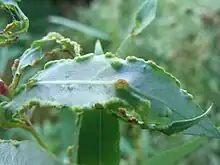| Aculus craspedobius | |
|---|---|
 | |
| Leaf galls caused by Aculus craspedobius | |
| Scientific classification | |
| Domain: | Eukaryota |
| Kingdom: | Animalia |
| Phylum: | Arthropoda |
| Subphylum: | Chelicerata |
| Class: | Arachnida |
| Family: | Eriophyidae |
| Genus: | Aculus |
| Species: | A. craspedobius |
| Binomial name | |
| Aculus craspedobius (Nalepa, 1925) | |
| Synonyms | |
|
Vasates craspedobius | |
Aculus craspedobius is a species of mite which causes galls on the leaves of willows (Salix species). It was first described by Alfred Nalepa in 1925.
Description
According to Redfern et al. (2011), the gall of A. craspedobius is similar to the gall of A. magnirostris and the mites need to be examined for firm identification. The gall of craspedobius is a short, 1–2 mm narrow twisted, downward roll on the leaves of eared willow (S. alba), crack willow (S. fragilis) and their hybrids in Great Britain. The gall is lined with red hairs and contains the mites.[1] Elsewhere it has been found on goat willow (S. caprea) and purple willow (S. pururea).[2]
In comparison, the galls of A. magnirostris differ by a longer downward roll on the leaf edge.[1] On the website Plant Parasites of Europe, photographs of A. magnirostris are similar to the description for A. craspedobius.[3]
Distribution
Aculus craspedobius has been found in Austria, Germany, Great Britain and Poland.[1][4]
References
- 1 2 3 Redfern, Margaret; Shirley, Peter; Bloxham, Michael (2011). British Plant Galls (Second ed.). Shrewsbury: FSC Publications. pp. 282–299. ISBN 978-1-85153-284-1.
- ↑ Ellis, W N. "Aculus craspedobius (Nalepa, 1925)". Plant Parasites of Europe. Archived from the original on 3 January 2018. Retrieved 2 January 2018.
- ↑ Ellis, W N. "Aculus magnirostris (Nalepa, 1892)". Plant Parasites of Europe. Archived from the original on 12 January 2018. Retrieved 11 January 2018.
- ↑ "Aculus craspedobius (Nalepa, 1925)". PESI portal. Retrieved 2 January 2018.